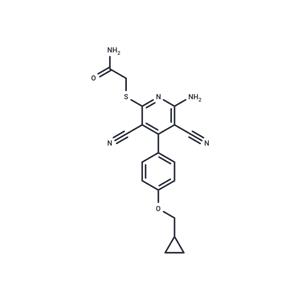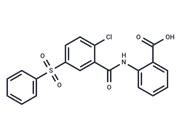| Name | BAY 60-6583 |
| Description | BAY 60-6583 is a potent, high-affinity adenosine A2B receptor agonist (EC50 = 3 nM) with affinity for A2B receptors that exceeds that for A1, A2A, and A3 receptors.BAY 60-6583 is cardioprotective in a model of myocardial ischemia.The Ki values for BAY 60-6583 binding to mouse, rabbit, and dog A2BAR were 750 nM, 340 nM, and 330 nM, respectively. The Ki values of BAY 60-6583 binding to A2BAR in mice, rabbits and dogs were 750 nM, 340 nM and 330 nM respectively. |
| In vitro | BAY 60-6583(0-10 μM) exhibits the maximum agonist effect of BAY 60-6583 in the absence of siRNA is 68 %.[3]
BAY 60-6583 (5 μM; 24 h) induces a rise in cell accumulation within the G1 phase while concurrently reducing the G2/M phase in RAW264.7 preosteoclasts. Additionally, under the same conditions, BAY 60-6583 specifically impedes Akt activation triggered by M-CSF, with no discernible impact on M-CSF-induced ERK1/2 activation in RAW264.7 preosteoclasts.[4] |
| In vivo | BAY 60-6583 (100 mg/kg; intravenous injection; rabbit) administered just before reperfusion, diminishes the infarction area in ischemic rabbit hearts.[1]
BAY 60-6583 (2 mg/kg; intravenous injection; mice) attenuates LPS-induced lung injury, pre-treatment with this compound can significantly decrease LPS-increased, IL-6 levels in WT mice.[2] |
| Storage | Powder: -20°C for 3 years | In solvent: -80°C for 1 year | Shipping with blue ice. |
| Solubility Information | DMSO : 90.0 mg/mL (237.2 mM), Sonication is recommended.
|
| Keywords | BAY 606583 | BAY 60-6583 | BAY 60 6583 |
| Inhibitors Related | Theophylline monohydrate | Diphylline | Acefylline | Nitrobenzylthioinosine | Aminophylline | Inosine | Theobromine | Istradefylline | Theophylline | Adenosine antagonist-1 | Doxofylline | FK-453 |
| Related Compound Libraries | Bioactive Compound Library | Neuronal Signaling Compound Library | Membrane Protein-targeted Compound Library | Bioactive Compounds Library Max | GPCR Compound Library |

 United States
United States



